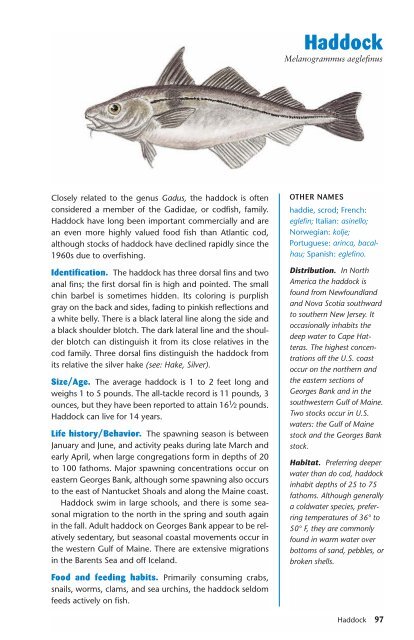Ken Schultz's Field Guide to Saltwater Fish - Macaw Pets store
Ken Schultz's Field Guide to Saltwater Fish - Macaw Pets store
Ken Schultz's Field Guide to Saltwater Fish - Macaw Pets store
Create successful ePaper yourself
Turn your PDF publications into a flip-book with our unique Google optimized e-Paper software.
Closely related <strong>to</strong> the genus Gadus, the haddock is often<br />
considered a member of the Gadidae, or codfish, family.<br />
Haddock have long been important commercially and are<br />
an even more highly valued food fish than Atlantic cod,<br />
although s<strong>to</strong>cks of haddock have declined rapidly since the<br />
1960s due <strong>to</strong> overfishing.<br />
Identification. The haddock has three dorsal fins and two<br />
anal fins; the first dorsal fin is high and pointed. The small<br />
chin barbel is sometimes hidden. Its coloring is purplish<br />
gray on the back and sides, fading <strong>to</strong> pinkish reflections and<br />
a white belly. There is a black lateral line along the side and<br />
a black shoulder blotch. The dark lateral line and the shoulder<br />
blotch can distinguish it from its close relatives in the<br />
cod family. Three dorsal fins distinguish the haddock from<br />
its relative the silver hake (see: Hake, Silver).<br />
Size/Age. The average haddock is 1 <strong>to</strong> 2 feet long and<br />
weighs 1 <strong>to</strong> 5 pounds. The all-tackle record is 11 pounds, 3<br />
ounces, but they have been reported <strong>to</strong> attain 16 1 ⁄2 pounds.<br />
Haddock can live for 14 years.<br />
Life his<strong>to</strong>ry/Behavior. The spawning season is between<br />
January and June, and activity peaks during late March and<br />
early April, when large congregations form in depths of 20<br />
<strong>to</strong> 100 fathoms. Major spawning concentrations occur on<br />
eastern Georges Bank, although some spawning also occurs<br />
<strong>to</strong> the east of Nantucket Shoals and along the Maine coast.<br />
Haddock swim in large schools, and there is some seasonal<br />
migration <strong>to</strong> the north in the spring and south again<br />
in the fall. Adult haddock on Georges Bank appear <strong>to</strong> be relatively<br />
sedentary, but seasonal coastal movements occur in<br />
the western Gulf of Maine. There are extensive migrations<br />
in the Barents Sea and off Iceland.<br />
Food and feeding habits. Primarily consuming crabs,<br />
snails, worms, clams, and sea urchins, the haddock seldom<br />
feeds actively on fish.<br />
Haddock<br />
Melanogrammus aeglefinus<br />
OTHER NAMES<br />
haddie, scrod; French:<br />
eglefin; Italian: asinello;<br />
Norwegian: kolje;<br />
Portuguese: arinca, bacalhau;<br />
Spanish: eglefino.<br />
Distribution. In North<br />
America the haddock is<br />
found from Newfoundland<br />
and Nova Scotia southward<br />
<strong>to</strong> southern New Jersey. It<br />
occasionally inhabits the<br />
deep water <strong>to</strong> Cape Hatteras.<br />
The highest concentrations<br />
off the U.S. coast<br />
occur on the northern and<br />
the eastern sections of<br />
Georges Bank and in the<br />
southwestern Gulf of Maine.<br />
Two s<strong>to</strong>cks occur in U.S.<br />
waters: the Gulf of Maine<br />
s<strong>to</strong>ck and the Georges Bank<br />
s<strong>to</strong>ck.<br />
Habitat. Preferring deeper<br />
water than do cod, haddock<br />
inhabit depths of 25 <strong>to</strong> 75<br />
fathoms. Although generally<br />
a coldwater species, preferring<br />
temperatures of 36° <strong>to</strong><br />
50° F, they are commonly<br />
found in warm water over<br />
bot<strong>to</strong>ms of sand, pebbles, or<br />
broken shells.<br />
Haddock 97


